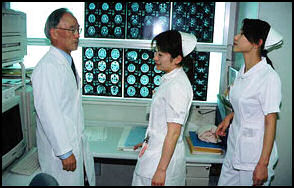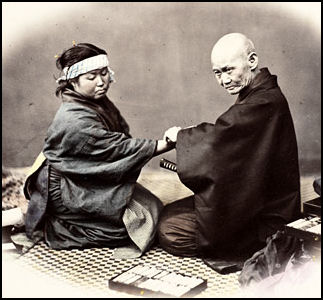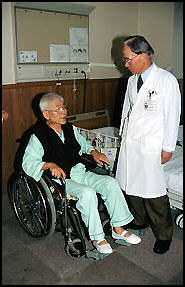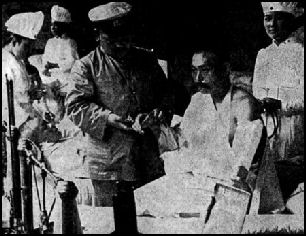HEALTH CARE IN JAPAN

brain surgeon with nurses The Japanese health care system has been widely praised for providing good universal health for relatively low cost. World's top health care systems: 1) France; 2) Italy; 3) San Marino; 4) Andorra; 5) Malta; 6) Singapore; 7) Spain; 8) Oman; 9) Austria; and 10) Japan. [Source: World Health Organization]
Systematized medical care in Japan dates from the introduction of Chinese medicine in the 6th century. This medical tradition produced many noted Japanese physicians and continued up to the Meiji Restoration (1868). At that time Western medicine was promoted as a national policy, and this led to the development of Japan’s modern medical system. Rapid economic growth in the postwar period brought a marked improvement in Japan’s standard of living, and, at the same time, remarkable progress was made in all aspects of public health. [Source: Web-Japan, Ministry of Foreign Affairs, Japan]
“Today the medical system in Japan is at the world’s highest level in many respects, such as average life expectancies and the death rates of infants and small children. At the same time, the system is faced with a number of challenges, including the small number of medical professionals (doctors, nurses, etc.) per bed and the long length of the average hospital stay. In the 21st century, the medical system will have to cope with changes in the disease structure, changes that include the growing prevalence of psychiatric disorders such as depression, the appearance of new infectious diseases like SARS, and, most of all, the greater number of cases of geriatric disease that will result from the rising average age of the population.
“National medical expenditures came to ¥36.6 trillion in fiscal 2010, or ¥282,400 per capita, and were equivalent to 10.61 percent of national income. The foundation of medical services in Japan is the “public universal health-care insurance system” in which every citizen in Japan is enrolled as a rule and a “free access system” that allows patients to choose their preferred medical facility. The health-care provision system has built in these two key aspects so that everyone, regardless of where they live, can be sure to obtain medical services. Efforts are also being made to introduce, on an experimental basis, new medical services for those living in remote locations, such as mountainous areas, so that they can receive medical services via the Internet and other communication technologies.
People per doctor: 610 (compared to 32,650 in Ethiopia, 611 in the United States and 210 in Italy). In 1970, more than 1,000 women died from problems related to childbirth. In 2007 only 35 died. In 1996 Japanese spent around $1,677 a year per capita on health care, 8 percent of GDP, and have a life expectancy of 83. By contrast Americans spent nearly $4,000 a year, 14 percent of GDP, and have a life expectancy of 76.
Books: “The Japan Healthcare Debate” by Mark A. Colby (Global Oriental, 2005); “Negotiating the Gray Maze: The Business of Medicine in Japan” by Mark A. Colby and Micheal P Birt; Good Websites and Sources: Photos of Health Care Workers japan-photo.de , Ambulance japan-photo.de ; and Neo-Natal Care at Japan-Photo Archive japan-photo.de ; Japan’s Health Care System nyu.edu/projects/rodwin ; 2009 Washington Post article About Japanese Health Care washingtonpost.com ; 2009 New York Times Blog Report prescriptions.blogs.nytimes.com ; NPR Report on Health Care in Japan npr.org/templates ; U.S. Versus Japan in Health Care livescience.com ; Public Health Insurance in Japan unpan1.un.org/intradoc ; Physician Job Satisfaction and Working Conditions in Japan pdf file joh.med.uoeh-u.ac.jp/pdf ; Japan Pharmaceutical Association nichiyaku.or.jp

Ministry of Health, Labor... Sites for Expats with Info on Health Care Japanable site for Expats japanable.com ; That’s Japan thats-japan.com ; Orient Expat Japan orientexpat.com/japan-expat ;Kimi Information Center kimiwillbe.com ;Foreign & Commonwealth Office Report on Japan fco.gov.uk/en/travel-and-living-abroad ; Student Guide to Japan www2.jasso.go.jp/study ; Japan in Your Palm japaninyourpalm.com
Links in this Website: HEALTH IN JAPAN Factsanddetails.com/Japan ;HEALTH CUSTOMS IN JAPAN Factsanddetails.com/Japan ; HEALTH CARE IN JAPAN Factsanddetails.com/Japan ; HEALTH CARE PROBLEMS IN JAPAN Factsanddetails.com/Japan ; ORGAN TRANSPLANTS IN JAPAN Factsanddetails.com/Japan ; HIGH TECH MEDICINE AND MEDICAL ADVANCES IN JAPAN Factsanddetails.com/Japan ; DISEASES AND HEALTH PROBLEMS IN JAPAN Factsanddetails.com/Japan ; HANDICAPPED PEOPLE IN JAPAN Factsanddetails.com/Japan
Good Websites and Sources on Health and Health Care: Statistical Handbook of Japan Health Care and Public Hygiene Section stat.go.jp/english/data/handbook ; 2010 Edition stat.go.jp/english/data/nenkan ; News stat.go.jp ; World Health Organization Japan who.int/countries/jpn ; Center for Disease Control in Atlanta CDC ; Medical Information for Foreigners pref.osaka.jp/iryo/medicalinfo ; Medical Resources by region compiled by U.S. Embassy /tokyo.usembassy.gov ; Japanese Government Organizations: Ministry of Health, Labour and Welfare mhlw.go.jp/english ; National Institute of Public Health niph.go.jp ; National Institute of Health Sciences nihs.go.jp ; National Institute of Health and Nutrition nih.go.jp/eiken
History of Health Care in Japan

19th century doctor The first ever operation performed under general anesthesia was performed in 1804 by a Japanese physician, Hanaoka Seishu, using a datura, a class of plants in the nightshade family that contains a powerful psycho active agents that produce vivid hallucinations followed by a long period of narcosis that can last for hours or even days.
Health and sanitation in Japan were greatly improved in the late 19th century by a Scotsman named William Burton, who redesigned Japan’s crumbling water supply system, improving drainage systems and sanitation, significantly reducing the threat of cholera that was killing thousands of Japanese at that time. Burton also is credited with buildings Japan’s first “skyscraper” — a 12-story pagoda with an elevator built in Tokyo.
One of the biggest health problems in Japan in the 19th century was the use of human sewage to fertilize rice fields. When it rained the sewage ended up in rivers which supplied drinking water. Burton help produce clean water by routing drinking water through purifying sand filers and storing it better in reservoirs.
Japanese Health Care System

brain surgeon with patient Universal health care is enshrined in the Japanese Constitution. A national health insurance system was established in 1961. Only conditions related to an ailment of some sort are covered by health insurance. Having a baby or other things not regarded as an illness or injury are not. In many cases local governments pick up the tab for having a baby.
Medical care is relatively cheap. A trip to the doctor costs $6.35, compared to $65 to $100 in the United States. Because of this people visit the hospital or even call an ambulance for relatively minor ailments. People often stay in the hospital much longer than they would for the same ailment in the United States.
Visits to clinics for health check ups are quick and efficient. Dentist give filing in less that 2 minutes. The waits can be long though. Japanese sometimes refer to their experience at the hospital as "three for three" — wait three hours and then spend three minutes with the doctor.
Medical care for infants is nearly free and the elderly only pay small fees. In many cases, people over 75 are only required to pay 10 percent of the medical costs incurred at hospitals. Insurance plans rarely resist paying for treatments ordered by doctors. In some cases aromatherapy and stress management are covered by health insurance.
U.S. Health Care Spending Highest, Japan Lowest: Study
In May 2011, a study of 13 industrialized countries released showed Japan spends the least on health care, while the United States spends the most without providing superior care for the money. The United States spent nearly $8,000 per person in 2009 on health care services, more than Australia, Britain, Canada, Denmark, France, Germany, Japan, the Netherlands, New Zealand, Norway, Sweden or Switzerland. Japan spent the least — $2,878 per capita in 2008 — according to the report by The Commonwealth Fund, a private foundation that promotes improved health care in the United States. [Source: Agence France-Presse, May 3, 2012]
“US health care spending amounted to more than 17 percent of gross domestic product in 2009, while Japan’s was under nine percent of GDP. “Japan operates a fee-for-service system, while offering unrestricted access to specialists and hospitals and a large supply of MRI and CT scanners,” said the report. “Rather than containing costs by restricting access, Japan instead sets health care prices to keep total health spending within a budget allotted by the government.”
“In contrast, the US system is beleaguered by higher prices, more readily accessible technology and widespread obesity. The United States had among the highest rates of potentially preventable deaths due to asthma and diabetes-linked amputations, and showed average rates of in-hospital deaths from heart attack and stroke, it said. Data for the study came from the Organization for Economic Cooperation and Development and other sources, the foundation said.
“Heart bypass surgery is very common in Japan, with more than 10,000 such operations conducted every year with a high rate of success. According to Ryohei Yozu, professor of cardiovascular surgery at Keio University School of Medicine, heart bypass surgery is more effective than catheter-based therapy in restoring blood flow."Japanese surgical technique while the heart continues to function is considered superior to that in the United States and Europe, and the operation is the most common treatment of this problem," Yozu said. "In general, patients are able to engage in physical exercise such as tennis about two months after the operation if their chest bones heal normally." [Source: Yomiuri Shimbun, February 14, 2011]
Japanese Health Insurance
A Health Insurance Law amendment which went into effect in 1961 entitles all Japanese citizens and resident aliens to coverage under one of six health insurance plans. Chief among them are employees’ health insurance, which covers most private-sector employees, and National Health Insurance, which covers the self-employed, the unemployed, retired persons, and other ineligible for employee health insurance. Other plans provide coverage for seamen, national public-service employees, local public-service employees, and private-school teachers and employees. [Source: Web-Japan, Ministry of Foreign Affairs, Japan]
“Under Japan’s medical insurance plans, 20 percent of medical expenses are paid by recipients for newborns and pre-elementary school children; 30 percent for elementary school children through to 69-year-olds; and 20 percent for those age 70 to 74 (however, this has been tentatively lowered to 10 percent as of 2010). Those 75 or older are enrolled in a separate system from the general health-care system, the Long Life Health Care System. The insurance carrier then remunerates the doctor, hospital, clinic, or other medical care provider directly for the remainder on a feefor- service basis as determined by the Ministry of Health, Labour and Welfare. This universal medical care insurance system gives all citizens access to adequate medical care, thus contributing greatly to their peace of mind and to the overall level of health in society.
About 20 percent of households covered by National Health Insurance have fallen into arrears as of 2008, leaving more than 30,000 children uninsured. The situation worsened in the economic crisis in 2008 and 2009. In January 2010 a special fees for emergency room visits by people with minor illnesses such as insect bites was introduced to help reduce the burden on doctors and the heath care system.
Need for Computerizing Medical Records in Japan
Medical records at many hospitals along the Tohoku coast were lost in the huge March 2011 tsunami. The Yomiuri Shimbun reported: “Even when their patients were taken in by other hospitals, it took some time for doctors to determine the most effective treatments because there was little information on hand about the patients' ailments, such as high blood pressure, and prescription drug records. Such a lack of medical information was also one of the major difficulties faced by doctors from across the country when they gathered at evacuation centers. The lives of more disaster victims could have been saved if records of their examinations and treatments had been quickly confirmed online.” [Source: Yomiuri Shimbun, Sept. 26, 2011]
The Internal Affairs and Communications Ministry is considering subsidizing the application of cloud computing to medical records. Electronically available medical information is useful not only in times of disaster but also in ordinary times. For example, cooperation between major hospitals and nearby clinics and between home-visit nurses and nursing care services could be made easier. Superfluous medical examinations and inconsistent drug prescriptions could be averted. Patients taken to hospitals for emergency treatment could receive the most appropriate treatment more quickly.
Computerization of medical information would also be helpful in regions suffering from a shortage of doctors. More integrated record-keeping among medical institutions would make it less necessary for local governments to maintain major central hospitals, thus facilitating a more efficient dispersal of personnel.
Health Care for Elderly
Public health insurance for the elderly falls into two categories: one for people aged 75 or older, and the other for those aged 65 to 75. As of March 2009, about 13.5 million people were covered by the schemes. Benefits are financed 50 percent by taxpayers money, about 40 percent by contributions from the working population, and about 10 percent by the insured people’s own premiums.
Premiums paid by individual are set by prefectural governments. In fiscal 2008, medical expenditures from the scheme totaled about $100 billion, or 33.5 percent of total medical care expenditures.
The system has been somewhat in disarray since the introduction of a new system in the spring of 2009 that aimed to get the elderly to pay a greater share of their health care and reduce the burden on future generations. The government elected in August 2009 said it would overhaul the system yet again and “abolish the system of categorizing people by age.”
Gastrostomy — the insertion of a feeding tube directly into the stomach — is a fairly common procedure among the elderly in Japan. About 400,000 people have been treated with the procedure. It allows people that can’t swallow or eat to get nourishment and helps keep many people alive — many suffering from dementia or severely debilitated after a stroke — much longer than they would if they didn’t have the procedure. In countries such as France, Sweden and the Netherlands the procedure is not carried out on patients with advanced dementia but in Japan it is.
Medical Services for the Elderly in Japan
The percentage of Japan’s population aged 65 or over was 7 percent in 1970. Just 41 years later, in 2011, it was more than 23.2 percent. As of April 2011, Japan had 29.76 million elderly people. Today one in every five people is 65 years or older, and in 2050 the ratio will likely be one in three. In 2008, medical expenditures of this group totaled 18.99 trillion yen, or 54.6 percent of the total, and per capita spending amounted to ¥673,400, as compared to ¥158,900 for those under 65. [Source: Web-Japan, Ministry of Foreign Affairs, Japan]
Through advances in medical treatment technology, the best medical care available can be given, yet at the same time this can lengthen the period of care. In addition, with the progressing trend toward nuclear families and women entering the work force, caring for the elderly at home has become difficult for some households. Concomitantly, there is a shortage of facilities such as nursing homes to care for the aged. This has led to the aged, who primarily require more nursing care than medical treatment, being cared for at hospitals for long periods of time rather than at nursing care facilities, thus accelerating the increase in medical expenditures for the elderly. In an attempt to improve the quality of elderly care, provide additional funding, and eliminate efficiencies that have resulted from the intermixing of medical treatment and long-term care functions, the government implemented a long-term care insurance system in 2000.
This system collects obligatory insurance contributions from a broad sector of the population (all persons aged 40 or older) and provides such services as home visits by home helpers, visits to care centers, and long-term stays in nursing homes for older persons suffering from senile dementia or confined to bed for health reasons. In each individual case, the need for such services has to be certified by city, town, and village offices in charge of administering the nursing care insurance system. Insurance contributions from persons aged 65 and over (“Type 1 insured persons”) are collected by the local administrations in the form of deductions from these persons’ pensions, while contributions from “Type 2 insured persons” between the ages of 40 and 64 are collected together with health insurance contributions as a lump sum.
Beneficiaries of the system must be at least 40 years old and must pay, in addition to the regular insurance contributions, 10 percent of the cost of services received. Japan’s nursing care insurance system is financed by: the national government (25 percent), prefectural and local governments (12.5 percent each), and insurance contributions (50 percent). A 2005 revision to the Long-Term Care Insurance Law added an emphasis on prevention aimed at helping those with relatively mild problems to maintain and improve their conditions, and thereby avoid deteriorating to the point where extensive care is necessary. This preventive care management is handled by community-based comprehensive support centers.
Doctors in Japan

hospital in 1905 Japanese have traditionally regarded the medical profession as kind of sacred and the judgement of doctors beyond reproach. Many patients do not seek a second opinion because their doctors consider it an insult.
Medical doctors receive licenses that are for good for life (doctors in the U.S. have to their licenses periodically reviewed). They are generally immune from public scrutiny and are not required by law to release their medical records.
Doctors generally work out of hospitals rather offices. The concept of a family doctor doesn’t really exist. When someone has a health problem they go to the hospital and visit whatever doctor is there that treats the problem the patient thinks he or she has.
Some doctors join “ikyoku”, closed groups that decide where doctors work and how much they get paid and other matters. There have been groups with dictatorial leaders that engaged in shady practices and forced doctors to work for little pay. Increasing young doctors are shunning these organization.
Some doctors do quite well. Doctors reportedly own more Rolls Royces than any other profession in Japan. Others are overworked and underpaid. Many see dozens of patients a day and are so squeezed for time they do perfunctory examination and don’t provide explanations. It is not uncommon for them to take a tip of $1,000 to $2,500 for delivering a baby.
Famous Doctors in Japan
Takanori Fukushoima is a world-renowned doctor at Mitsui Memorial Hospital in Tokyo. Sometimes called “the hands of God,” he pioneered the use of microscopes in surgery and developed keyhole surgery — a method of operating that avoids large incision and leaves behind only a small scar that is one or two centimeters long. He conducts more than 600 operations a year, including ones other doctors refuse to undertake, and performs procedures using delicate movement of less than one millimeter with extraordinary precision. He sometimes carries out two ir three operations at a time, subsisting on little more than energy drinks and rice balls bought at convenience store for meals.
“Shigeaki Hinohara, the director of St. Luke's International Hospital in Tokyo, was still working at the age of 100. As the head of St. Luke's, he oversaw the medical treatment of victims of the sarin nerve gas attack on the Tokyo subway system in 1995. In 1970, he was among passengers taken hostage by Red Army faction members who hijacked the Yodo, a Japan Airlines jetliner.
Long Hours for Doctors in Japan

ad for an energy drink Doctors have a lot of clerical duties such as entering data in computers, filling out documents for private insurance companies, issuing medical certificates and writing letters of introduction in addition to their regular duties. One survey found that 90 percent of doctors feel burdened by the amount of paperwork they are required to do.
Hospital-hired doctors work especially hard. One survey found that 30 percent of them had worked for a month straight without taking any days off.
Obstetricians and pediatricians often put in regular hours in the day and handle emergency cases at night, exhausting themselves working long hours, burning themselves out and endangering patients.
The government health ministry is currently working on ways to reduce the workload of hospital doctors such as adhering strictly to night or day shifts, encouraging work sharing, hiring more people to take care of paper work and adhering to rules that give doctors two days off a week and prevent them from working more than 16 hours at a time.
Medical Tourism in Japan
Japan is making an effort to enter the medical tourism business, attracting wealthy people in need of medical attention mainly from Arab countries, China and Russia. In 2010, the Japanese government set the goal of transforming the medical service field into a ¥59 trillion business by 2010. In January 2011 Japan began issuing six-month medical visas to allow visitors that much time to receive medical treatment in Japan. The Japanese government plans to set up a special office that will promote medical tourism in Japan.
One “medical tourist” — a Saudi man who was given cutting-edge heart surgery in which muscle cells from his legs were used too repair his heart — told the Yomiuri Shimbun, “This treatment is just great. I believe it will help tens of thousands of patients in the future.”
Image Sources: 1) Visualizing Culture, MIT Education 1.5) Japan-Photo.de, 2) Nature Products 3) Golden Bamboo 4) Iron Palm Arts 5) 6) 7) and Japan-Photo.de
Text Sources: New York Times, Washington Post, Los Angeles Times, Daily Yomiuri, Times of London, Japan National Tourist Organization (JNTO), National Geographic, The New Yorker, Time, Newsweek, Reuters, AP, Lonely Planet Guides, Compton’s Encyclopedia and various books and other publications.
Last updated October 2012
